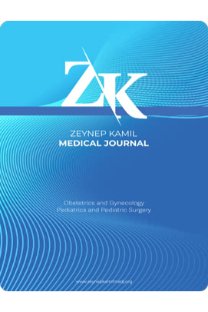Endometrium kanseri evrelemesinde laparoskopik yöntem ile laparotomik yöntemin perioperatif ve postoperatif karşılaştırılması
endometrium kanseri, cerrahi evreleme, laparoskopi, laparotomi
Perioperative and postoperative outcomes of laparoscopy and open method for surgical staging of endometrial cancer
endometrial carcinoma, laparoscopy, laparotomy, surgical staging,
___
- 1. Ferlay J, Shin HR, Bray F, Forman D, Mathers C, Parkin DM. Estimates of worldwide burden of cancer in 2008: GLOBOCAN 2008. International journal of cancer. 2010;127(12):2893-917.
- 2. Walker JL, Piedmonte MR, Spirtos NM, Eisenkop SM, Schlaerth JB, Mannel RS, et al. Recurrence and survival after random assignment to laparoscopy versus laparotomy for comprehensive surgical staging of uterine cancer: Gynecologic Oncology Group LAP2 Study. Journal of Clinical Oncology. 2012;30(7):695.
- 3. Kornblith AB, Huang HQ, Walker JL, Spirtos NM, Rotmensch J, Cella D. Quality of life of patients with endometrial cancer undergoing laparoscopic international federation of gynecology and obstetrics staging compared with laparotomy: a Gynecologic Oncology Group study. Journal of Clinical Oncology. 2009;27(32):5337.
- 4. Galaal K, Bryant A, Fisher AD, Al‐Khaduri M, Kew F, Lopes AD. Laparoscopy versus laparotomy for the management of early stage endometrial cancer. Cochrane Database of Systematic Reviews. 2012(9).
- 5. Tozzi R, Malur S, Koehler C, Schneider A. Laparoscopy versus laparotomy in endometrial cancer: first analysis of survival of a randomized prospective study. Journal of minimally invasive gynecology. 2005;12(2):130-6.
- 6. Malzoni M, Tinelli R, Cosentino F, Perone C, Rasile M, Iuzzolino D, et al. Total laparoscopic hysterectomy versus abdominal hysterectomy with lymphadenectomy for early-stage endometrial cancer: a prospective randomized study. Gynecologic Oncology. 2009;112(1):126-33.
- 7. Mourits MJ, Bijen CB, Arts HJ, ter Brugge HG, van der Sijde R, Paulsen L, et al. Safety of laparoscopy versus laparotomy in early-stage endometrial cancer: a randomised trial. The lancet oncology. 2010;11(8):763-71.
- 8. Janda M, Gebski V, Brand A, Hogg R, Jobling TW, Land R, et al. Quality of life after total laparoscopic hysterectomy versus total abdominal hysterectomy for stage I endometrial cancer (LACE): a randomised trial. The lancet oncology. 2010;11(8):772-80.
- 9. Chu L-H, Chang W-C, Sheu B-C. Comparison of the laparoscopic versus conventional open method for surgical staging of endometrial carcinoma. Taiwanese Journal of Obstetrics and Gynecology. 2016;55(2):188-92.
- 10. Obermair A, Manolitsas TP, Leung Y, Hammond IG, McCartney AJ. Total laparoscopic hysterectomy for endometrial cancer: patterns of recurrence and survival. Gynecologic oncology. 2004;92(3):789-93.
- 11. Boosz A, Haeberle L, Renner SP, Thiel FC, Mehlhorn G, Beckmann MW, et al. Comparison of reoperation rates, perioperative outcomes in women with endometrial cancer when the standard of care shifts from open surgery to laparoscopy. Archives of gynecology and obstetrics. 2014;290(6):1215-20.
- 12. Juhasz-Böss I, Haggag H, Baum S, Kerl S, Rody A, Solomayer E. Laparoscopic and laparotomic approaches for endometrial cancer treatment: a comprehensive review. Archives of gynecology and obstetrics. 2012;286(1):167-72.
- 13. Lu Q, Liu H, Liu C, Wang S, Li S, Guo S, et al. Comparison of laparoscopy and laparotomy for management of endometrial carcinoma: a prospective randomized study with 11-year experience. Journal of cancer research and clinical oncology. 2013;139(11):1853-9.
- 14. Terai Y, Tanaka T, Sasaki H, Kawaguchi H, Fujiwara S, Yoo S, et al. Total laparoscopic modified radical hysterectomy with lymphadenectomy for endometrial cancer compared with laparotomy. Journal of Obstetrics and Gynaecology Research. 2014;40(2):570-5.
- 15. Lutman CV, Havrilesky LJ, Cragun JM, Secord AA, Calingaert B, Berchuck A, et al. Pelvic lymph node count is an important prognostic variable for FIGO stage I and II endometrial carcinoma with high-risk histology. Gynecologic oncology. 2006;102(1):92-7.
- 16. Lim PC, Kang E, Park DH. A comparative detail analysis of the learning curve and surgical outcome for robotic hysterectomy with lymphadenectomy versus laparoscopic hysterectomy with lymphadenectomy in treatment of endometrial cancer: a case-matched controlled study of the first one hundred twenty two patients. Gynecologic Oncology. 2011;120(3):413-8.
- 17. Santi A, Kuhn A, Gyr T, Eberhard M, Johann S, Günthert AR, et al. Laparoscopy or laparotomy? A comparison of 240 patients with early-stage endometrial cancer. Surgical endoscopy. 2010;24(4):939-43.
- 18. Scholz HS, Petru E, Benedicic C, Haas J, Tamussino K, Winter R. Fibrin application for preventing lymphocysts after retroperitonal lymphadenectomy in patients with gynecologic malignancies. Gynecologic oncology. 2002;84(1):43-6.
- 19. Gallotta V, Fanfani F, Rossitto C, Vizzielli G, Testa A, Scambia G, et al. A randomized study comparing the use of the Ligaclip with bipolar energy to prevent lymphocele during laparoscopic pelvic lymphadenectomy for gynecologic cancer. American journal of obstetrics and gynecology. 2010;203(5):483. e1-. e6.
- 20. Eisenkop SM. Total laparoscopic hysterectomy with pelvic/aortic lymph node dissection for endometrial cancer—a consecutive series without case selection and comparison to laparotomy. Gynecologic oncology. 2010;117(2):216-23.
- 21. Muntz HG, Goff BA, Madsen BL, Yon JL. Port-site recurrence after laparoscopic surgery for endometrial carcinoma. Obstetrics & Gynecology. 1999;93(5):807-9.
- 22. Fanning J, Hossler C. Laparoscopic conversion rate for uterine cancer surgical staging. Obstetrics & Gynecology. 2010;116(6):1354-7.
- 23. Walker JL, Piedmonte MR, Spirtos NM, Eisenkop SM, Schlaerth JB, Mannel RS, et al. Laparoscopy compared with laparotomy for comprehensive surgical staging of uterine cancer: Gynecologic Oncology Group Study LAP2. Journal of Clinical Oncology. 2009;27(32):5331.
- 24. Palomba S, Falbo A, Mocciaro R, Russo T, Zullo F. Laparoscopic treatment for endometrial cancer: a meta-analysis of randomized controlled trials (RCTs). Gynecologic oncology. 2009;112(2):415-21.
- ISSN: 1300-7971
- Yayın Aralığı: 4
- Başlangıç: 1969
- Yayıncı: Ali Cangül
Vuslat Lale BAKIR, Gül KARAHAN
Preeklampsi, Maternal ve Fetal Etkileri, Yönetimi Önlenmesine Yönelik Girişimler ve Hemşirenin Rolü
Baki ERDEM, Osman AŞICIOĞLU, Gökçe TURAN, İlkbal Temel YÜKSEL, Osman Samet GÜNKAYA, İpek Yıldız ÖZAYDIN, Işıl Şafak YILDIRIM, Doğukan YILDIRIM, Özgür AKBAYIR
Doğan VATANSEVER, Burak GİRAY, Yasemin ABOALHASAN
Gebelerde cinsel fonksiyon değerlendirmesi: Serum androjen ve fetal cinsiyet ilişkisi
Şengül AYDIN YOLDEMİR, İsmet Çigdem KILIÇ
Sporcu Lisansı İçin Başvuran Çocukların Retrospektif Değerlendirilmesi
Nilüfer ÇETİNER, İbrahim Hakan BUCAK, Habip ALMIŞ, Fedli Emre KILIÇ, Mehmet TURGUT
ThinPrep ve Konvansiyonel Yöntem ile Çalışılan Servikal Smear sonuçların Değerlendirilmesi
Resul ARISOY, Cihangir YILANLIOĞLU, Koray ÖZBAY, Altuğ SEMİZ, Alparslan DENİZ
Pediatrik öncü B-ALL’ye Moleküler Yaklaşım
